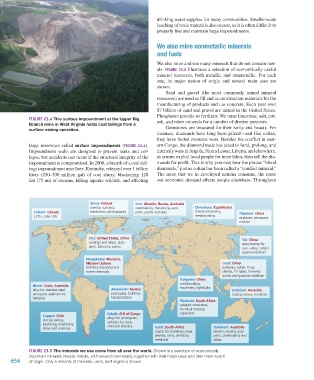Page 657 - Environment: The Science Behind the Stories
P. 657
drinking water supplies for many communities. Smaller-scale
leaching of toxic materials also occurs, as it is often difficult to
properly line and maintain large impoundments.
We also mine nonmetallic minerals
and fuels
We also mine and use many minerals that do not contain met-
als. Figure 23.5 illustrates a selection of economically useful
mineral resources, both metallic and nonmetallic. For each
one, its major nation of origin and several main uses are
shown.
Sand and gravel (the most commonly mined mineral
resources) are used as fill and as construction materials for the
manufacturing of products such as concrete. Each year over
$7 billion of sand and gravel are mined in the United States.
Phosphates provide us fertilizer. We mine limestone, salt, pot-
Figure 23.4 This surface impoundment at the Upper Big ash, and other minerals for a number of diverse purposes.
Branch mine in West Virginia holds coal tailings from a
surface mining operation. Gemstones are treasured for their rarity and beauty. For
instance, diamonds have long been prized—and like coltan,
they have fueled resource wars. Besides the conflict in east-
large reservoirs called surface impoundments (Figure 23.4). ern Congo, the diamond trade has acted to fund, prolong, and
Impoundment walls are designed to prevent leaks and col- intensify wars in Angola, Sierra Leone, Liberia, and elsewhere,
lapse, but accidents can occur if the structural integrity of the as armies exploit local people for mine labor, then sell the dia-
impoundment is compromised. In 2000, a breach of a coal tail- monds for profit. This is why you may hear the phrase “blood
ings impoundment near Inez, Kentucky, released over 1 billion diamonds,” just as coltan has been called a “conflict mineral.”
liters (250–300 million gal) of coal slurry, blackening 120 The more that we in developed nations consume, the more
km (75 mi) of streams, killing aquatic wildlife, and affecting our economic demand affects people elsewhere. Throughout
Silver: Poland Iron: Ukraine, Russia, Australia
jewelry, currency, steelmaking, metallurgy, auto Chromium: Kazakhstan
Indium: Canada electronics, photography parts, paints and dyes chemical industry, Titanium: China
LCDs, solar cells metalworking airplanes, aerospace,
missiles
Zinc: United States, China Tin: China
coatings and alloys, auto steel plating for
parts, batteries, paints cans, alloys, solder,
superconductors
Phosphates: Morocco,
Western Sahara Lead: China
fertilizer, industrial and batteries, solder, X-ray
home chemicals shields, TV tubes, formerly
paints and gasoline additives
Tungsten: China
metalworking,
Nickel: Cuba, Australia machinery, lightbulbs
alloy for stainless steel, Aluminum: Guinea Uranium: Australia
aerospace applications, packaging, building, nuclear power, medicine
batteries transportation
Platinum: South Africa
catalytic converters,
chemical industry,
Cobalt: D.R of Congo capacitors
Copper: Chile alloys for jet engines,
electric wiring,
plumbing, machinery, carbides for tools,
chemical industry
alloys and coatings Gold: South Africa Tantalum: Australia
ingots for monetary value, electric circuitry, auto
jewelry, coins, dentistry, parts, steelmaking and
medicine alloys
Figure 23.5 The minerals we use come from all over the world. Shown is a selection of economically
important minerals (mostly metals, with several nonmetals), together with their major uses and their main nation
656 of origin. Only a minority of minerals, uses, and origins is shown.
M23_WITH7428_05_SE_C23.indd 656 13/12/14 11:29 AM

